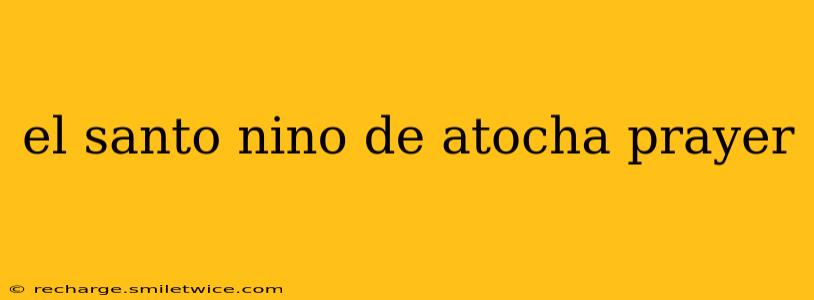El Santo Niño de Atocha, the Holy Child of Atocha, is a beloved figure of faith, particularly in Spain and throughout the Americas. His image, depicting a young Jesus carrying a staff and often depicted with a donkey, evokes powerful feelings of protection, hope, and healing. Millions turn to him in prayer, seeking his intercession in times of need. This article delves into the history and devotion surrounding El Santo Niño de Atocha, exploring common prayers and answering frequently asked questions.
Who is El Santo Niño de Atocha?
El Santo Niño de Atocha is not a canonized saint in the traditional sense, but rather a deeply venerated image of the infant Jesus. His origins trace back to a 13th-century image in the Spanish town of Atocha, near Madrid. The statue, often depicted in simple clothing and carrying a pilgrim's staff, became associated with helping travelers, the poor, and the marginalized. His popularity spread rapidly throughout Spain and later, with Spanish colonization, to Mexico, South America, and other parts of the world.
The image's popularity is intertwined with many miraculous stories attributed to his intercession. These narratives, passed down through generations, solidify El Niño de Atocha's place in the hearts and prayers of countless devotees. Many believe that he offers particular protection to miners, travelers, and children, reflecting the historical context of his early worship.
What are some common prayers to El Santo Niño de Atocha?
While specific prayers vary among devotees and different traditions, the core themes remain consistent: supplication for protection, guidance, healing, and the relief of suffering. Many prayers begin with an invocation of the Holy Child, often highlighting his attributes of compassion and mercy. Here's a sample prayer, bearing in mind that personal heartfelt prayer is most effective:
"Oh, Holy Child of Atocha, I come before you with a humble heart, seeking your loving protection and guidance. I entrust my [mention your need or request] into your tender care. I implore you, through your compassionate heart, to intercede on my behalf. Amen."
You can expand this prayer by adding specific details about your situation and expressing your gratitude for his blessings. Remember, sincerity and faith are paramount in prayer.
What are the origins of the devotion to El Santo Niño de Atocha?
The precise origins of the devotion are somewhat shrouded in history, but the image itself dates back to the 13th century in Atocha, Spain. Its association with miners likely stems from the town's proximity to mining areas. Legends and oral traditions recount miraculous interventions attributed to the child's image, further solidifying its popularity and fostering fervent devotion among the people. The spread of the devotion across continents reflects the expansion of Spanish influence and the persistence of faith traditions across vast distances.
Where is the Shrine of El Santo Niño de Atocha?
The original shrine dedicated to El Santo Niño de Atocha is located in the Sanctuary of Atocha in Madrid, Spain. However, countless other churches and shrines throughout the world, particularly in Latin America, are dedicated to him, demonstrating the widespread nature of his devotion. Many of these locations contain replicas of the original image, fostering localized devotion and creating a vibrant tapestry of faith.
Are there specific novenas or rosaries dedicated to El Santo Niño de Atocha?
Yes, many devotees pray novenas (nine-day prayers) and rosaries dedicated to El Santo Niño de Atocha. These prayers often incorporate specific intentions and requests, reflecting the diverse needs of the faithful. While standardized versions may exist within specific communities, individual prayer styles and traditions are also prevalent, highlighting the deeply personal nature of faith. The most important aspect of these practices remains the sincere devotion and faith expressed through prayer.
How can I best show my devotion to El Santo Niño de Atocha?
Devotion to El Santo Niño de Atocha manifests in various ways. Prayer, of course, is central. Attending Mass or visiting a shrine dedicated to him are also common expressions of faith. Many devotees also make offerings, such as candles or flowers, as a token of their gratitude and appreciation. The most important element, however, is a sincere heart filled with faith and trust in the intercession of the Holy Child.
By understanding the history, prayers, and traditions surrounding El Santo Niño de Atocha, we gain a deeper appreciation for this revered figure and the enduring power of faith. The devotion to this Holy Child continues to inspire hope and comfort across generations and continents.
